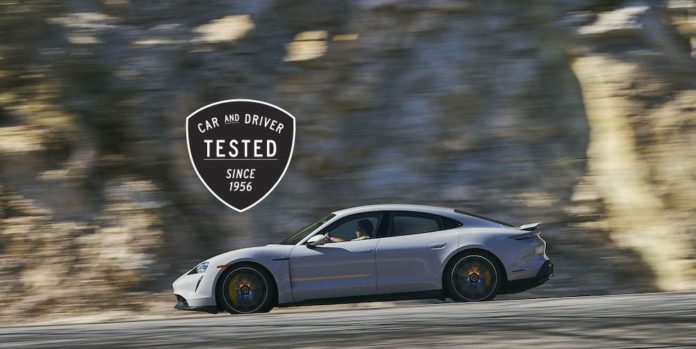- Over time, the Porsche Taycan Turbo S quietly got quicker, even though early 2020 and more recent 2023 examples both sprint to 60 mph in 2.4 seconds.
- The cars diverge at 90 mph, where the 2023 model bests the original by two tenths. The gap rises to 0.5 second at 100 mph and a full second to 150 mph.
- Two software updates account for the improvement, and your older Turbo S may have already received them if you’ve taken it in for unrelated service.
Welcome to Car and Driver’s Testing Hub, where we zoom in on the test numbers. We’ve been pushing vehicles to their limits since 1956 to provide objective data to bolster our subjective impressions (you can see how we test here).
When it first came out in 2020, the Porsche Taycan Turbo S endured lots of smack-talk because of the Turbo script emblazoned on its hind end. But there was no denying it was turbo quick, and its 2.4-second 60-mph sprint and 10.5-second quarter-mile that topped at 130 mph were no laughing matter. Recently, a funny thing happened when we tested a 2023 Turbo S to help our friends at sister publication Road & Track: we discovered that the newer car was substantially faster at the top end.
More Boost = More Speed
The two cars are just as quick to 60 mph, as both hit that milestone in an identical 2.4 seconds. But the new car steadily pulls ahead thereafter, arriving at 90 mph in 4.7 seconds instead of 4.9 seconds. The quarter-mile arrives in 10.3 seconds and 132 mph instead of 10.5 ticks and 130 mph. Beyond that, the fresher machine reaches 120 mph in 8.3 seconds instead of 8.8 seconds. At the 150-mph mark, the score was 14.2 seconds to 15.2 seconds.
What’s going on? It’s down to a very turbo-sounding word: boost. Or, more specifically, overboost. In the EV world, you can allow more power to flow to the motors for short periods to generate temporary bursts of added performance, but you much ration out those moments so excess heat doesn’t build up and damage the works. In the Taycan Turbo S, overboost only functions in Sport Plus mode under launch-control conditions. That alone makes it a rare enough event, but there’s also the question of how long you let it persist.
When the Taycan Turbo S was first rolled out, the conservative answer was three seconds. In later iterations, overboost was allowed to persist for a full 10 seconds. Porsche made this change after understanding in-use customer behavior of their first EV in more detail and also after the ongoing testing that Porsche has always done to constantly improve their products. The effect of 10 seconds of overboost versus three seconds is exactly what our two test results have quantified.
Two Main Software Updates
These benefits are down to two software updates that were put into effect after the car launched. The first was the more minor of the two, and it occurred in August 2020. This added a Plug & Charge feature, a Battery Save mode, a color head-up display, and an unheralded performance update that related to how aggressively the front motor’s power was deployed.
The second update in March 2021 was more meaningful as far as raw performance goes. It was a partial reaction to the existence of the rear-drive Taycan, the development and introduction of which lagged behind the all-wheel-drive model. Early AWD Taycans operated in front-wheel drive when Range mode was enabled, but a pure rear-drive Taycan obviously couldn’t work that way. In the end, the fresh rear-drive Range mode strategy the engineers worked out for the RWD machine was clever enough to roll out to the AWD cars. Overboost has no application in the context of a rear-drive Taycan, of course, but the three- to 10-second boost in overboost was rolled during the same update with little fanfare.
Not Over the Air
If you own one of the older cars, it’s very likely that you have received one or both of these updates without necessarily knowing it. The word “likely” is important here, because Porsche tells us that safety- and performance-related updates will never be pushed out over the air. (The 2020 Taycan isn’t even OTA-capable, but that’s another story and is beside the point.) Instead, updates like this are performed on a routine basis when the diagnostic equipment is plugged in during a dealer visit, even if you brought the car in for something unrelated.
Moral of the story: If you own a 2020 or early 2021 Taycan Turbo S and have never taken it in to a dealer, you may be missing out—particularly if you’re an overboost booster. If you’re unsure of the update status of your early AWD Taycan and want to perform a quick check, put it in Range mode and look at the traction display to see which wheels are driving it down the road.
It’s tempting to question why an EV needs any dealer attention, but the Taycan is Porsche’s first EV. The company is still refining what it is to be an electric Porsche, and they don’t mind sharing new developments. They are a little wary of pushing everything out via OTA updates, though.
Technical Editor
Dan Edmunds was born into the world of automobiles, but not how you might think. His father was a retired racing driver who opened Autoresearch, a race-car-building shop, where Dan cut his teeth as a metal fabricator. Engineering school followed, then SCCA Showroom Stock racing, and that combination landed him suspension development jobs at two different automakers. His writing career began when he was picked up by Edmunds.com (no relation) to build a testing department.


